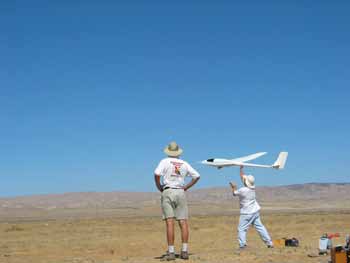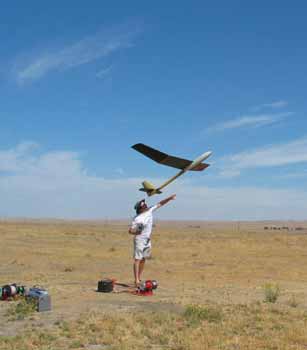California Valley
Cross Country Radio Controlled
Sailplane Race. September 2004
I read about an upcoming
Sailplane race in the online magazine RC Soaring Digest,
http://www.b2streamlines.com/RCSD.html
The event would happen at California Valley near the Carrizo Plain,
September 18 and 19th. We had driven through the Carrizo Plain
during a Spring Break years ago and it is a vast, empty, beautiful
place. I decided to go.
Thursday, September 16
After a eight hour drive I arrived near the Carrizo Plain and looked for my spot for the night. I found a two rut road that went up over a hill and out of sight. Perfect!

Peace and quiet and an occasional coyote sing during the night. My kind of camping!
Friday, September 17

I arrived at the event location and by golly, these guys know how to live! A Lodge and a Restaurant reserved for the contestants!!

Some of the teams had already arrived and were starting to set up their planes.
And a swimming pool! You got to be kidding! No Fun Fly or Lake Fly I ever attended had a swimming pool!

Way too much civilization for my taste. I moved out to the launch site and set up camp!!
During the day various teams launched and fine tuned their planes; getting ready for the weekend.
September 18
Saturday morning.
After a sit down breakfast in the restaurant, Mike, the Contest
Director, convened a pilots meeting and announced the rules; "Use
plenty of sun screen. Drink lots of water. Don't forget to
buckle up." (Buckle up??)
He handed out maps of the course, and announced the "task" for the
day.

"Today is a distance task. Cover as many miles as you can before 'landing out'. The course opens at 9:00 AM and closes at 4:00 PM. You can go either direction from the launch point, which is Point A. The map notes the miles between points. Pilots are not required to go around the course but they must include at least three points. For instance, you can elect to go from A to G to D, back to G, back to A and repeat that route again if desired. Good luck."
I raced out to my camp spot by the launch site and waited. I soon found out what really determined the route was the conditions at launch; the heat of the day, the way the wind was blowing! Nobody was in a hurry! The teams were waiting for the day to warm up and the thermals to start happening!

Finally one team launched.
A battery powered winch is used and the guy launching the plane controls the pull of the winch with a foot pedal.

The winch gets the sailplane up to around five hundred feet. Then it is time to start hunting for thermals. If a thermal isn't found the plane will be back on the ground in a few minutes and another launch tried.
Everyone is looking around for circling buzzards, hawks, floating dust and paper, anything indicating lift. When lift is spotted, the pilot launches and heads the plane for the thermal, gets into it, and starts circling and rising, what they call, "tanking up". Soon the plane reaches a point where I can hardly see it! The team would assist the pilot, who is watching his plane, over to the waiting vehicle.

The "co-pilot" would take over flying the plane while the pilot climbed into the back of the pickup and buckled himself into one of the seats!

Then the co-pilot climbs in the other seat, buckles up, and the third member of the team, the driver, heads out onto the course, the pilot flying, and the co-pilot looking for more thermals!! Away they go!

Other teams launched and soon, Mike and his co-pilot go for it.

They catch a thermal and invite me to come along. Mike's wife Cindy driving.

This photo is looking back out the window of the cab as we zip down the road at thirty five miles per hour!! Mike flying, his co-pilot spotting. The seats swivel in the bed of the pickup so the pilot and co-pilot can keep orientated to the plane. They occasionally holler for Cindy to "up five" or "down five" the speed of the truck so they can keep up with the plane as they "make distance". Of course, when distance is being made, the plane is going in a straight line trajectory and losing altitude so spotting a possible thermal up ahead is critical. When another thermal is found Cindy stops beside the road while they "tank up" in a thermal. When good altitude is gained, off we go again! Cindy announced up coming situations like "cattle guard" or "left turn" so the pilots would not be startled and/or distracted!!
I soon discovered my eyes are too old for this game! Most of the time I could not even see the plane! The leading edge of some of the planes had a chrome or iridescent strip that would flash in the sun when circling and that would help locate the plane when it was way up there.

Like this. Note the green flash on the wing of this plane coming in for landing.


Each plane has an onboard device called a "Vario" that allows the pilot to know if his plane is gaining or losing altitude; note the radio receiver on the hip and the headset. Some planes also haul along a GPS unit that is plugged into a laptop, after the flight, to show the complete flight history! Some planes went over 3,500 feet above launch height when tanking up!!

The course closed, evening arrived, dinner was served, and Mike announced the results of the day.
Sixth place
17.4 miles
Fifth place 44.4 miles
Fourth place 79.4 miles
Third place 91.3 miles
Second place 99.1 miles
and first place...
112 miles!!!
A guy named Joe won the event and did it in a total time of just under six hours!
Sunday September 19th
Breakfast and Mike announced the days "task".
"Fly around the map's short course of 22.7 miles. You can go clockwise or counter clockwise. The team that gets around quickest wins. The course closes at 3:00 PM. Good luck!"
Once again it is a lazy
start as the teams wait for the day to warm.
While everyone is waiting Mike helped me launch and trim my Bird of
Time.




What goes up, must come down.
Over the course of several launches I was able to catch a thermal once. My best time was seven minutes! This soaring stuff is tricky business! Really makes me appreciate what these guys can do!

Here is a group photo of one of the teams.
Eventually everyone got into the air.
Three o'clock arrived and the course was closed. Time to announce the day's winner.

Once again Joe won with a
elapsed time around the course of 36 minutes!
The next closest team came in at 1 hour and 35 minutes!
And, the amazing thing was...


During Joe's launch he lost contact with his plane due to an electrical failure while still attached to the cable! The plane arched up, over, and straight into the ground, totally destroying it. The photo on the right shows Joe and his wife returning with their plane. Soon after Joe put the pieces away one of the guys from another team came over and offered Joe the use of their back-up plane. Joe flew it for the first time and beat everyone with it both days! Amazing! Joe really proved that it is the knowledge of the environment and how it works that makes all the difference in Cross Country soaring!
What a great bunch of guys and gals.
Nothing left for me to do but head for home! What an amazing weekend.